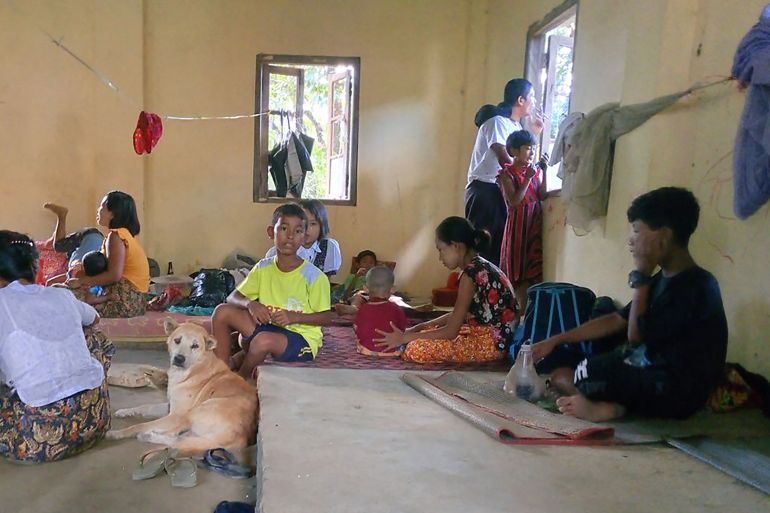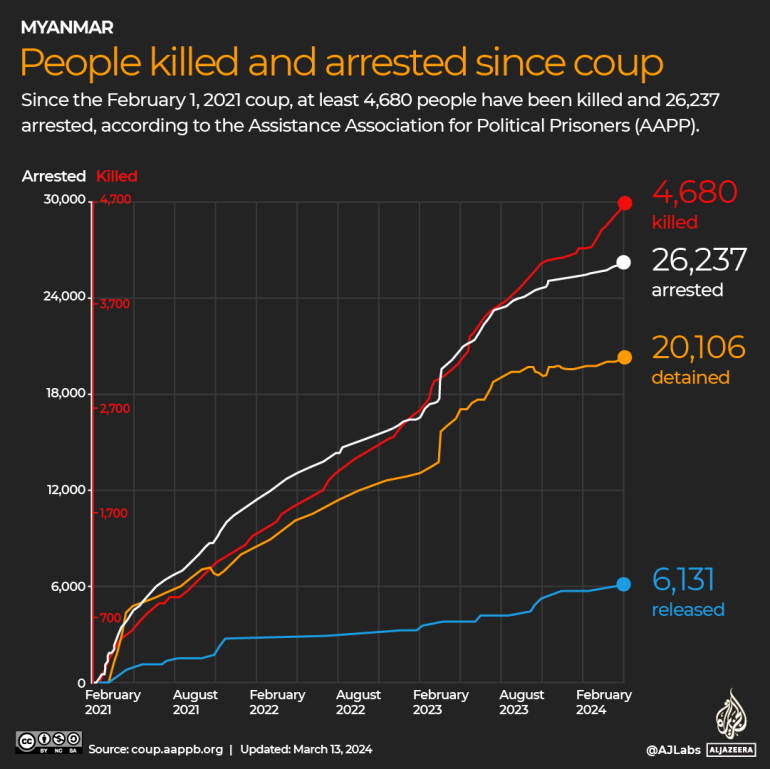How is renewed violence in Myanmar affecting the Rohingya?
A recent surge in violence by armed groups in Myanmar is causing upheaval and displacement among Rohingya once again.

The Rohingya are yet again bearing the brunt of renewed fighting and military air strikes in Myanmar, United Nations chief Antonio Guterres warned this week.
The latest wave of fighting by armed groups who want to overturn the country’s 2021 military coup flared up at the end of October last year. The military extended the country’s state of emergency in January and announced a new, mandatory conscription programme in February, which many fear may also disproportionately affect the Rohingya people.
Keep reading
list of 4 itemsAmnesty calls for war crimes probe over Myanmar military bombing of church
Myanmar’s rebels see unity as key to victory over weakened military rulers
‘Blood and sweat’: Myanmar resistance fights to overturn military coup
Not only are the Muslim-majority Rohingya being bombed “indiscriminately” but they are also being forcefully drafted into the army even though they are not recognised as citizens and have long been subject to persecution by the the Myanmar authorities, particularly the military.
Here’s what we know so far:
What is happening in Myanmar?
Myanmar, formerly known as Burma, was under military rule for five decades until the 2015 election, when Aung San Suu Kyi won a landslide victory. However, the military led a coup against her on February 1, 2021, prompting mass protests that evolved into an armed uprising after the generals responded with force.
The Assistance Association for Political Prisoners (AAPP), which has been tracking the crackdown, says 4,680 people have been killed by the Myanmar military since the coup.
Most recently, the Three Brotherhood Alliance, a coalition of ethnic armed groups – the Arakan Army, the Myanmar National Democratic Alliance Army (MNDAA) and the Ta’ang National Liberation Army (TNLA) – launched a major offensive in October 2023.
Codenamed Operation 1027, the offensive that began on October 27 last year led to the fall of more than 100 military posts as soldiers retreated and left heavy weapons and significant ammunition behind. Anti-coup resistance forces, including the People’s Defence Forces, have also joined the fight adding to the pressure on the generals.
In November 2023, the military announced that it had lost control of Chinshwehaw, which borders China’s Yunnan province and is central to the flow of trade from Myanmar to China, after days of fighting with armed groups.
In January, the Arakan Army, which has long fought for autonomy in western Rakhine state, said it had taken full control of a key western town, Paletwa, in neighbouring Chin state, having overrun several military outposts.
The military has responded with force. Many of the country’s remaining Rohingya live in camps in Rakhine where their movements are severely restricted.
“The Myanmar junta has been indiscriminately bombing Rohingya areas in different townships in Rakhine state,” said Nay San Lwin, co-founder of the Free Rohingya Coalition, a global network of Rohingya activists.
Quoting local sources, Nay San Lwin said 23 Rohingya, including children and a religious scholar, were killed on Monday during the bombardment of western Minbya township. Additionally, 30 Rohingya were injured. “These attacks on Rohingya are happening everywhere,” said Nay San Lwin.
Other factors, such as a declining economy and depleting natural gas reserves, which are a crucial revenue source for the military regime, have further undermined its legitimacy.
A recent mandatory conscription order has triggered panic throughout Myanmar, with many residents looking for ways to escape. For the Rohingya, however, avoiding the draft is particularly difficult due to their restricted mobility.

Who are the Rohingya?
The Rohingya are a Muslim-majority ethnic group in Myanmar. Myanmar is ethnically diverse, with 135 major ethnic groups and seven ethnic minority states, according to the international human rights organisation, Minority Rights Group. Among these, the Burmese are the largest and most dominant group.
The Rohingya are not acknowledged in this list of 135 groups and have been denied citizenship in Myanmar since 1982. Nearly all the Rohingya live in the coastal state of Rakhine, which was called Arakan until 1990.
While Aung San Suu Kyi’s electoral victory was initially viewed as a desperately needed reprieve from a long period of unjust military regimes, she remained silent on the issue of the Rohingya.
The Myanmar military has repeatedly cracked down on the Rohingya in Rakhine since the 1970s.
In 2017, a violent military crackdown forced more than 700,000 Rohingya refugees to flee across the border into Bangladesh. During crackdowns, refugees have often reported rape, torture, arson and murder by Myanmar security forces.
The crackdown is the subject of an ongoing genocide case at the International Court of Justice in The Hague.
How does the new conscription law affect the Rohingya?
On February 10, the Myanmar military government announced that it would enact the People’s Military Service Law which makes conscription mandatory for young men and women, but which had lain dormant since it was passed under a previous military administration in 2010.
The UN Special Rapporteur for human rights in Myanmar, Tom Andrews, said the mandatory draft was a sign of the military’s “weakness and desperation”.
Men aged 18 to 35 and women aged 18 to 27 can be drafted into the armed forces for two years at a time, and this term can be extended to five years when a national emergency is declared.
Nay San Lwin told Al Jazeera that local sources had reported at least 1,000 people from the Rohingya community being taken by the military from three towns – Buthidaung, Sittwe and Kyaukphyu.
Nay San Lwin added that some have already completed two weeks of training and been taken to the battlefield. “Dozens have been killed on the battlefield while being used as human shields in Rathedaung township,” he added. The Myanmar military has previously used porters as human shields.
Al Jazeera has not been able to independently verify these accounts of conscription of the Rohingya.
#Breaking – Disturbing reports that #MyanmarMilitary vehicles arrived at Bawdupha IDP camp in #Sittwe to forcibly recruit more #Rohingya IDPs. Brave women came out with machetes and swords, saying we cannot send our children and husbands to the battlefields. (1/2)
— Tun Khin (@tunkhin80) March 14, 2024
Rakhine state has experienced communications blackouts since at least 2019. A blackout was reinstated in January this year with only limited access to communications since then.
Zaw Win, a human rights specialist at the independent Southeast Asia-based rights group, Fortify Rights, said that during these limited periods, the group has received phone calls from Rohingya people saying they have witnessed friends and family members being taken from camps for internally displaced people (IDPs) in Rakhine by the military.
Zaw Win added that his team had interviewed a man who had “witnessed how the junta military took away the Rohingya youth from Ward 5, Buthidaung. The military came in their vehicle and caught the Rohingya”, he said.
However, he said that Fortify Rights has not been able to independently verify these reports so far.
Tun Khin, a Rohingya activist and the president of the Burmese Rohingya Organisation UK in London, also highlighted reports of forced recruitment via his account on X.
The military government has not issued any official statement about the recruitment of the Rohingya into the armed forces, but Nay San Lwin said it had issued a denial that young Rohingya were “forcibly recruited, arrested and then taken to military battalions for training” via state newspapers in both English and Burmese.
#MyanmarMilitary abducted 25 #Rohingya men during evening prayers yesterday at Dar Paing IDP camp mosque in #Sittwe in this holy month of #Ramadan.We believe they have been forcibly conscripted like hundreds of others, likely to be used as human shields. #WhatsHappeningInMyanmar
— Tun Khin (@tunkhin80) March 15, 2024
It is especially difficult for the 600,000 Rohingya living in camps and villages in Rakhine to leave Myanmar in order to escape conscription, activists say.
To move from one village to another, individuals must obtain permission from the village administrators who are also Rohingya but act under orders from the military. This process can be long and costly, requiring approvals from several different local government departments.
Activists claim recruiting the Rohingya is designed to create communal tensions between the Rohingya and the Rakhine Buddhists.
Videos surfaced on social media on March 19 showing the Rohingya apparently protesting against the Arakan Army. However, many X users speculated that this was a military-sponsored protest.
In an X post, Aung Kyaw Moe, cabinet member of Myanmar’s National Unity Government, made up of elected MPs removed in the coup – wrote: “Junta is using the Rohingya as a proxy to protest against AA [Arakan Army] in Buthidang is not definitely organic.”
Junta is using the Rohingya as a proxy to protest against AA in Buthidang is not definitely organic. It is not that easy for the Rohingya suddenly to come together in hundred of people in a Random morning to protest. We , the Rohingya must be politically very cautious and be in… pic.twitter.com/DGgWm5bl2e
— Aung Kyaw Moe (@akmoe2) March 20, 2024
How has the international community responded?
Myanmar’s 2017 military crackdown on the Rohingya has been under investigation by the International Criminal Court (ICC) since 2019. However, there has been a lack of progress in the case.
“It has been three years since the coup, and not a single ICC member state has referred Myanmar to the ICC. I think that’s a practical failure, it’s a moral failure. But it’s one that can be rectified,” said Matthew Smith, executive director of Fortify Rights.
A separate case was also filed by The Gambia in 2019 at the ICJ, accusing Myanmar of committing genocide against the Rohingya. While the ICJ issued orders for provisional measures to be taken by Myanmar to protect the Rohingya, Nay San Lwin and Smith said that nothing was done.
“The UN Security Council should regard the Myanmar military flouting the provisional measures as a reason for action,” said Smith.
Nay San Lwin said that the Rohingya crisis could be resolved if a civilian government which acknowledges the plight of the Rohingya comes to power. Furthermore, he said: “If the international community takes serious action against the military, we will not suffer.”
As the situation in Myanmar has grown increasingly perilous & the conscription law is enforced, @john_hq3, director @FortifyRights said “The Indian government really should focus on protecting refugees along the border and providing them with a safe haven.”https://t.co/jdCtAHOVP8
— Fortify Rights (@FortifyRights) March 14, 2024